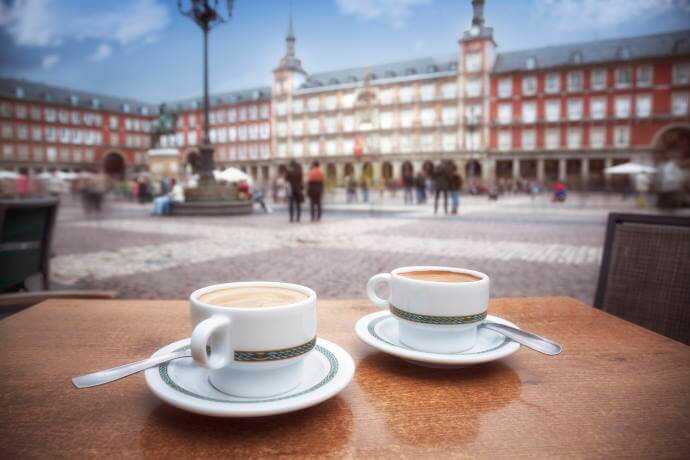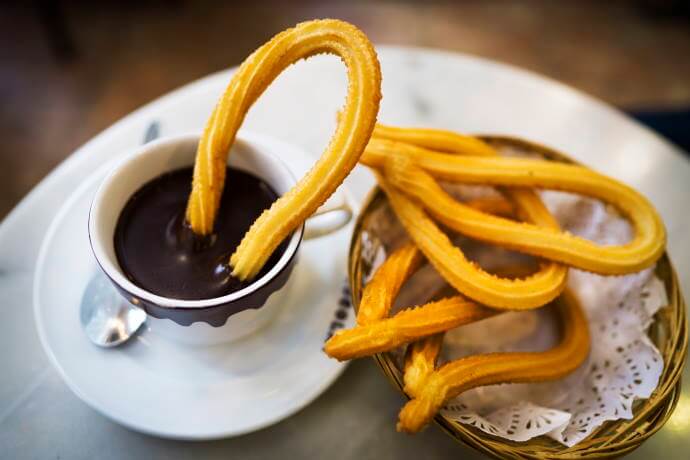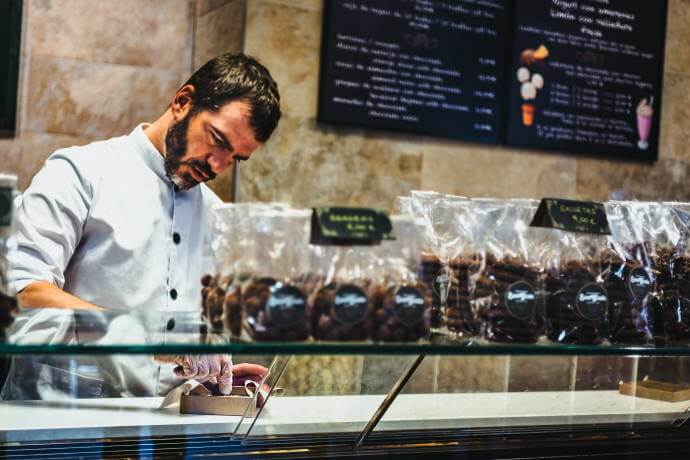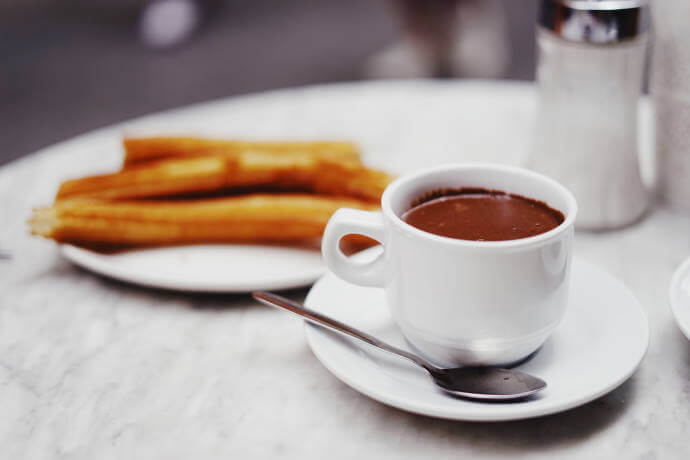Chocolate with churros is a traditional delicacy of Spanish gastronomy, also present in several Latin American countries for more than a century now. It is eaten as breakfast at very early hours and sometimes it is served as a snack. Often eaten during the cold winter months, this traditional dish is a balanced contrast of flavors, mixing the bitter sweetness of the chocolate with the salty aromas of the crunchy churro.
Breakfast with churros in Madrid dates back almost to the beginning of the 19th century and it is quite possible that the churro was first introduced in the street fairs that frequently roamed the capital. The popularity of the churro -or its larger variant, the porra- as a breakfast grew until it became highly popular due to its low cost. Chocolate, on the other hand, has a longer history, whose invention and name date back to Mexico and its pre-Hispanic cultures, and is derived from cocoa, also native to Mexico, where it was once a common currency among pre-Columbian peoples of Mesoamerica.

The exact moment between the 19th and early 20th centuries when the breakfast pairing of these two elements (chocolate and churros), was invented is unknown. Some say that it could have been actually around the 1920s. We guess that perhaps popular curiosity was responsible for that spontaneous matching! It is called chocolate con churros indicating that the hot cocoa (generally between 75 °Celsius and 80 °Celsius or 167ºF and 176ºF) is served in a porcelain cup along with a plate with freshly made churros. The regular portion usually contains between six and eight churros depending on the size. Sometimes porras are served instead of churros, and this depends mainly on the person’s taste.
Depending on the places where it is served, the plate of churros may or may not come with a sugar packet to be sprinkled on and a pitcher with cold water to appease any sudden thirst that might appear after having eaten the sugary breakfast.
The way it is done is a very simple way: a churro is taken and dipped in the hot chocolate in the cup, sometimes with sugar sprinkled over the churros beforehand. The rest of the chocolate that remains after eating the churros is usually drunk. The churro can be served hot or cold. It is more common in the north of Spain to serve it cold while in the south it is served hot.
Tradition says that...

Chocolate with Churros is both a breakfast or a late-night snack and a social act. The meal is usually taken at cafes or bars sitting around the marble tables and seen as an opportunity for conversation with your neighbors at the next table or a social gathering if it is planned in advance. Similarly, the famous Roscón de Reyes a Christmas sweet is usually taken just like chocolate with churros, except that instead of dipping the churro, a portion of the roscón is dipped. In some countries like Cuba as in Spain at the end of the 18th century, it is associated to a food served during the “banquetes velorios”, a meal served at wakes and memorials. Churros became immensely popular in Madrid in the beginning of the 20th century as an after-theater treat, where people would relish on this sweet and share thoughts and ideas on the plays they have just watched.
So where can I find it?

The place where you can have a chocolate with churros is what is called “churrería”. It is usually a place with abundant marble decoration reminiscent in part of the years of the early 19th or 20th century. The structure of these historic bars and cafes is usually typical of past times: a cashier takes the order for the number of servings of churros, charges and gives the customer a receipt that serves as proof to present at the "bar" where the order is served. It does not take long, usually just a couple of minutes. In some churrerías of Madrid, due to the great affluence of public, there is the custom of sharing the table. The smell of the oil frying the churros and the sweet aroma of boiling cocoa is a part of these churrerías. Here you can also order coffee with milk and churros and even anise, cognac, etc. There is the possibility of ordering a take out and take the chocolate and churros in a container, some of the traditional chocolaterias already offer this service.
The churrerías are open from as early as 5:00 or 6:00 in the morning, as its popular use started with the workers of the first hour of the morning. Nowadays the concept has been changing little by little and young people who stay up late during the weekends or local festivities usually end up sitting down to breakfast in these early churrerías.
Chocolate with churros is also served in any cafeteria or terrace. Little by little the fast pace of the cities is making the demand for street stalls to serve churros, so it is not difficult to see more and more stalls and food trucks next to universities, main squares and railroad stations. Some catering companies even offer, among their many culinary services, breakfasts with chocolate and churros.
Each churrería has its own atmosphere and a different way of making churros, in some places they are made elongated, in others folded, ribbed, frying the dough more or less, with or without sprinkled sugar on top, etc. It is all a matter of adapting to the taste of the owner and the diners who frequently attend the place. As a general rule, the churro is prepared at the moment it is ordered, which makes it crispy and fresh.
In Madrid two of the most traditional are the Chocolatería San Ginés and La Mallorquina both located in the historic center and a mandatory visit when in the city. In Palma de Mallorca, the Ca'n Joan de S'Aigo, inaugurated in 1700 is very famous. When in Santander (Cantabria), the churrería Áliva is one of the best and most traditional. In Malaga the most traditional place to have chocolate with churros is Casa Aranda and in Marbella, Churrería Ramón.
We leave you with one of the recipes for this traditional so you can start perfecting your own version of Chocolate con Churros. By the time that you get to Spain you will be an expert on it!

For the Churros
You will need:
- 125 ml (1/2 cup) water
- 125 ml (1/2 cup) whole milk
- 110 grams of butter
- 1 tablespoon of sugar
- 1 pinch of salt
- 150 grams (about 1 cup + 2 tablespoons) all-purpose flour
- 3 large eggs at room temperature
- sunflower oil, for frying
cinnamon and sugar, for coating
Next steps:
1. Pour the water, milk, butter, sugar and salt in a medium saucepan and heat just to boiling point. Turn off the heat and immediately add the flour. Stir the mixture with a wooden spoon until it becomes a wet dough ball.
2. Pour the oil in a cast iron skillet or deep fryer, and heat over medium heat until it reaches 180ºC (356ºF).
Meanwhile take the flour and butter mixture to a mixer and mix the dough for a few minutes until it cools down.
Add the eggs one at a time. Once the dough is uniform, turn off the mixer, and transfer part of the dough to a pastry bag with a special tip for churros.
3. Once the oil is hot, press the piping bag and pour portions of the batter into the oil, using a knife, scissors or your fingers to cut the pieces. Fry for about 2-3 minutes on each side. Remove and place them on absorbent paper/paper towels to absorb the excess oil. Add cinnamon or sugar to the hot churros.
For the Hot Chocolate
You will need:
- 400 g of dark chocolate in bar (we suggest a minimum of 70% cocoa)
- 1 liter of whole milk
- a cinnamon stick for flavoring (optional)
- optional: 30 g sugar
Next steps:
1. In a saucepan bring the milk to a heat. If you want you may add sugar as well as cinnamon stick to build the aroma. Stir a little so that the sugar (if you have added it) dissolves. Chop the chocolate, and when the milk is hot, but not boiling, add it to the pan. Mix with a spoon or rods so that the chocolate dissolves and integrates.
2. When it starts to boil, remove from the heat, and when it stops bubbling, put it back on the heat until it starts to boil again. This double boiling makes the chocolate thicker. Then remove from the heat and serve.
3. If you like a thicker chocolate, you can remove a little milk from the total and dissolve 15 g of cornstarch in it. Once the chocolate has melted, before it starts to boil, add the milk with the dissolved cornstarch and stir well.
Enjoy!



